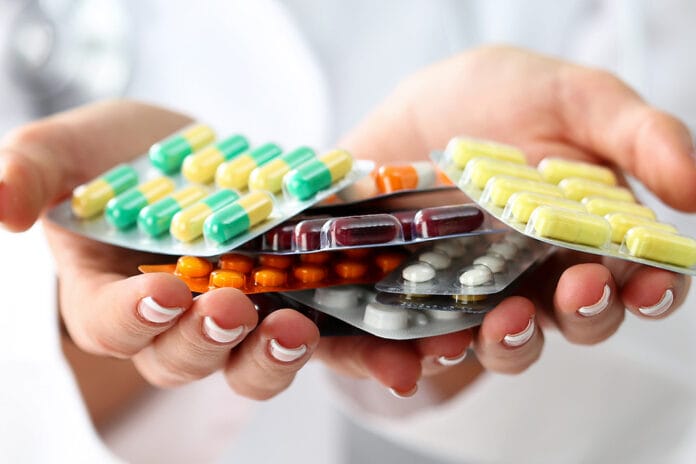Antidepressants are used to correct chemical imbalances in the brain. The body naturally produces brain chemicals called neurotransmitters, which correlate with depression, such as serotonin and dopamine to provide happiness to the brain. Norepinephrine is another neurotransmitter to help treat depression by focusing on attention, promoting concentration, responding to stress, boosts energy, increases alertness and arousal.1 Most medications relieve depression by affecting these neurotransmitters, which aid in communication between the brain cells.
When the brain receives too much or too little, depression can occur. Depression is not black and white. There are many versions ranging from mild and temporary to severe and permanent. Antidepressants are a common and popular treatment choice for depression. Several are on the market, and it may take a few medications to determine which works best.
Some dental impacts of antidepressants are mentioned in the review of medications below. In addition, dental patients who suffer from depression may allow moods to alter oral health routines.
Finding the right medication depends on specific symptoms, possible side effects, interactions with other medications, and other health conditions. Although these medications do not cure depression, they may help relieve symptoms. The prescribing doctor may recommend combining two antidepressants or add other medication to an antidepressant to enhance the effects. Someone may temporarily be on antidepressants to get through a certain life situation, or they may be on antidepressants throughout life.
Physical Reactions to Antidepressants
Dopamine − Dopamine regulates mood and muscle movement and plays a critical role in the brain’s pleasure and reward systems. It is used to create chemicals of norepinephrine and epinephrine. Dopamine is stored in the brain and engages in the feeling of euphoria, bliss, and enhanced motivation and concentration.
This is the neurotransmitter that is used in addiction. Higher levels of dopamine are achieved with certain foods, illicit drugs, and engaging in risky behavior such as gambling. The caution with dopamine enhancers is that it reaches a threshold, and more drug is needed to keep that enhancement for the high.2 In addition, when using medications for dopamine, it reduces the body’s natural ability to produce it.
Norepinephrine − Norepinephrine is both a hormone and a brain neurotransmitter and stored in the nerve cells. It passes nerve impulses from nerve to nerve. It’s released into the bloodstream by the adrenal glands and works alongside adrenaline (epinephrine) to give the body energy in times of stress.1
Serotonin − Serotonin is a neurotransmitter, a chemical that carries signals between nerve cells in the brain. It helps with mood, emotion, and sleep. It has been suggested depression may arise from low serotonin levels. Although serotonin does a fair amount of its work for the brain, it is stored in the gut. It helps not only mood and emotions but also gut mobility, metabolism, digestive and appetite functions.2
Mood Disorders
Bipolar disorder: Bipolar disorder is a serious mental illness. People who have it go through unusual mood changes. They may be extremely happy and active and then very sad, feeling hopeless and inactive with a continual cycle of ups and downs. They often have normal moods in between. The up feeling is called mania. The down feeling is depression.3
Generalized anxiety disorder: Excessive, ongoing anxiety and worry that is difficult to control and interferes with day-to-day activities.4
Major depressive disorder: Persistent and intense feelings of sadness for extended periods of time, also referred to as clinical depression. It impacts mood and behavior as well as various physical functions.5
Obsessive-compulsive disorder: A mental disorder in which people have recurring unwanted thoughts, feelings, ideas, and sensations called obsessions. While compulsions are the behaviors that drive them to do something repeatedly.6
Panic disorder: Panic attacks are sudden episodes of intense fear that trigger severe physical reactions when there’s no danger or apparent cause. Panic disorders are recurrent panic attacks with the fear of when the next one is to happen. With the overwhelming fear and attacks, it feels like the loss of control, heart attack, or even dying.7
Post-traumatic stress disorder: A mental health condition that’s triggered by either witnessing or experiencing a traumatic event. Recurrence of flashbacks, nightmares, severe anxiety, and uncontrollable frightful thoughts about the event may last for months or years.8
Premenstrual dysphoric disorder: Similar to premenstrual syndrome but more severe and even debilitating. It causes severe irritability, depression, and anxiety in the few weeks leading up to menstruation and subsides within three days after menstruation starts.9
Social anxiety disorder: A chronic mental health condition with extreme fear, stress, and anxiety in a social setting. It can cause life disruption in daily life where social interactions cause significant self-consciousness and embarrassment.10
Antidepressants in Children and Teenagers
Antidepressants are an effective way to treat depression and anxiety in children and young adults. There’s an increased risk of suicidal thinking and behavior of people under the age of 25. The highest risk is during the initial first few months of taking antidepressants and when the dosage is increased or decreased.
The only FDA-approved antidepressants for children and teens are as follows:
- Six and older: Zoloft for obsessive-compulsive disorder.
- Seven and older: Cymbalta for generalized anxiety disorder and Prozac for obsessive-compulsive disorder.
- Eight and older: Prozac for major depressive order and fluvoxamine for obsessive-compulsive disorder.
- Ten and older: Clomipramine for obsessive-compulsive disorder and Symbyax for bipolar disorder.
- Twelve and older: Lexapro for major depressive order.11
Review of Antidepressant Medications
Serotonin and norepinephrine reuptake inhibitors (SNRIs)
Serotonin and norepinephrine reuptake inhibitors (SNRIs) inhibit the reuptake of norepinephrine and serotonin and increases these chemicals in the brain. Serotonin regulates mood and anxiety, while norepinephrine mobilizes the brain for action to improve energy and attentiveness. Effective in treating mood disorders with depression.12,13
Side effects of SNRIs, usually subside after a few weeks:
- Anxiety
- Constipation, difficulty urinating
- Dizziness
- Fatigue, drowsiness
- Nausea and vomiting
- Loss of appetite
- Excessive sweating
- Sexual difficulties
Other uses: Fibromyalgia, chronic pain, nerve pain, bipolar and anxiety disorder.
- Cymbalta (duloxetine): Cymbalta was the second SNRI to be approved in the United States and has the highest number of FDA approvals for treating various illnesses. Treats mainly major depressive disorder, general anxiety disorder, fibromyalgia, chronic musculoskeletal pain, peripheral neuropathic pain, and nerve pain. Doses depend on treatment.
- Effexor (venlafaxine): Effexor is the first SNRI to be FDA approved. Used for depression. Initial dose 75 mg two to three divided doses a day. The maintenance dose increased to 225 mg once a day. Maximum dose 375 mg in three divided doses a day.
- Pristiq, Khedezla (desvenlafaxine): Pristiq and Khedezla are the third SNRI to be FDA approved only for major depressive disorder. Initial dose 50 mg once a day. Maintenance dose 50 mg once a day. Maximum dose 400 mg daily, although doses greater than 50 mg usually provide no real additional benefit.
- Fetzima (levomilnacipran): Fetzima is the most recent SNRI approval and is FDA approved only for depression. The initial dose 20 mg once a day, then after two days increased to 40 mg once a day. Maintenance dose 40 to 120 mg once a day. Maximum dose 120 mg.
Drug interactions and precautions for SNRIs: Abilify, Adderall, Lyrica, Vyvanse, other antidepressants, blood thinners and renal disease, seizures, and hypertension.
Dental concerns of SNRIs: Xerostomia, drooling, postural hypotension (dizziness when standing after lying or sitting), and bruxism.12,14
Selective serotonin reuptake inhibitors (SSRIs)
Selective serotonin reuptake inhibitors are the most widely used class of antidepressants. They work by increasing serotonin in the brain by blocking serotonin’s reuptake, making serotonin available to pass further messages between nerve cells.
They do not affect norepinephrine as the other antidepressant classes do. Selective serotonin reuptake inhibitors have fewer and milder side effects, fewer drug interactions, and are less likely to be associated with suicide. Although with the start of SSRIs, some people may have suicidal thoughts and desire to self-harm. People 25 years and under are particularly at risk. Selective serotonin reuptake inhibitors causes are less likely to cause problems at higher therapeutic doses than other antidepressants.13
Side effects of SSRIs:
- Indigestion, diarrhea, constipation
- Blurred vision
- Weight loss initially, weight gain with long-term use
- Increased blood sugars
- Feeling agitated, shaky, or anxious
- Feeling sick
- Excessive sweating
- Low sex drive, erectile dysfunction, or achieving orgasm13
Antidepressant tachyphylaxis: Antidepressant tachyphylaxis, also called antidepressant “poop out,” is when a drug that was once effective at treating symptoms of depression no longer works. Prozac and Zoloft are the most common SSRIs to have this effect. Up to 57% of antidepressant users will experience a depression relapse over a one-year period.15
Serotonin syndrome: Serotonin syndrome is rare, although potentially serious side effects are linked to SSRIs. It occurs when levels of serotonin become too high. It is commonly triggered when an SSRI is used in combination with other medications that also raise serotonin levels.
Symptoms of serotonin syndrome:
- Confusion
- Agitation
- Muscle twitching
- Sweating
- Shivering
- Diarrhea
Severe symptoms of serotonin syndrome:
- High temperature above 100.4 degrees
- Seizure
- Arrhythmia
- Loss of consciousness
Hyponatremia: Hyponatremia is another potential side effect that happens when there’s a severe decrease in sodium levels. Selective serotonin reuptake inhibitors block the effects of the hormone that helps regulate levels of sodium and leads to a buildup of fluid inside the body’s cells. Geriatric people are at the most risk.17
Mild side effects of hyponatremia:
- Feeling sick
- Headache
- Muscle pain
- Reduced appetite
- Confusion
Severe side effects of hyponatremia:
- Feeling listless and tired
- Disorientation
- Agitation
- Psychosis
- Seizure fits
- Coma
Other uses: Generalized anxiety disorder, obsessive-compulsive disorder, panic disorder, bulimia, post-traumatic stress disorder, fibromyalgia, premenstrual syndrome, premature ejaculation, and irritable bowel syndrome.
- Prozac (fluoxetine): Used for depression, panic, anxiety, or obsessive-compulsive disorder. Doses depend on treatment.
- Paxil (paroxetine, pexeva): Used for obsessive-compulsive disorder, social anxiety disorder, post-traumatic stress disorder and premenstrual dysphoric disorder. Doses depend on treatment.
- Zoloft (sertraline): Used for depression, obsessive-compulsive disorder, post-traumatic stress disorder, social anxiety disorder, bulimia nervosa, and premenstrual dysphoric disorder. Most effective, causes less sleepiness, and best choice for pregnant women.16
- Celexa (citalopram): Used for depression. Initial dose 20 mg once a day. Maintenance dose 20 to 40 mg once a day. Maximum dose 40 mg once a day.
- Lexapro (escitalopram): Used for major depressive order and anxiety. Dose depends on treatment.
Drug interactions and precautions for SSRIs: Diabetes, NSAIDs, lithium, triptans, TCA’s, MAOIs, SNRIs, clozapine, pimozide, antiplatelets, alcohol, cocaine, caffeine, and St. John’s Wort.17
Dental concerns of SSRIs: Xerostomia, dry throat and lips, oral soreness or burning, dysgeusia (altered taste), halitosis, and bruxism.
Monoamine oxidase inhibitors (MAOIs)
Monoamine oxidase inhibitors (MAIOs) were the first type of medication for the treatment of depression. They have been mostly replaced by antidepressants that are newer, safer, and have fewer side effects. Many of these medications have severe warnings of increased depression and suicidal thinking and behavior of adults under the age of 25.
MAOIs work by inhibiting monoamine oxidase, which is an enzyme that breaks down the neurotransmitters that control mood, serotonin, dopamine, and norepinephrine. This results in higher levels of chemicals in the brain to improve mood and reduce anxiety.
Monoamine oxidase inhibitors are rarely prescribed anymore. With these medications, it’s recommended to start with an initial dose. Then continue with an increase to the maximum clinical response as required. Then a slow reduction, over the next several weeks, of the medication to find the right therapeutic dose is required.
Side effects of MAOIs:
- Weight gain
- Fatigue, weakness, drowsiness
- Anxiety, agitation, mood change
- Vomiting, nausea,
- Headache
- Abdominal pain
- Involuntary muscle jerks
- Impotence
Other uses: Parkinson’s disease, bulimia, borderline personality disorder, and agrophobia.18
- Marplan (isocarboxazid): Used for depression, anxiety, panic, and phobias. Doses depend on treatment.
- Nardil (phenelzine): Used for severe depression and bipolar. Doses depend on treatment.
- Parnate (tranylcypromine): Major depressive disorder. Initial dose 30 mg in divided doses. Increase to 30 mg twice a day. Maximum dose 60 mg a day.
- Emsam (selegiline): Major depressive disorder. This medication is a skin patch with a variety of doses.
Drug interactions and precautions for MAOIs: Alka-Seltzer, Dayquil, cough and cold medications, aspirin, anti-inflammatory drugs, opioids, alcohol, other antidepressants, seizure medications, and foods with tyramine can cause a hypertensive crisis.18,19
Dental concerns of MAOIs: Xerostomia and postural hypotension.
Tricyclics
Tricyclics work by blocking the absorption of serotonin and norepinephrine causing the increase of these neurotransmitters to be present in the brain and produce an antidepressant effect. The increase of serotonin and norepinephrine levels in the brain help improve mood and relieve depression. Tricyclics were among the first antidepressants and have been replaced by SSRI’s, SNRI’s and other depressants. These meds are prescribed when other depressants are not working effectively since they are more powerful with more side effects.13 Many of these medications have severe warnings of increased depression and suicidal thinking and behavior of adults under the age of 25.
Side effects of tricyclics:
- Increased blood sugars
- Dizziness
- Headaches
- Blurred vision, dry eyes
- Fatigue
- Weight gain
- Seizure
- Low blood pressure
- Sexual dysfunction
- Constipation, urinary retention
Other uses: Neuropathic pain, fibromyalgia, migraines and headaches, attention deficit hyperactivity disorder, and bulimia nervosa.
- Elavil (amitriptyline): Used for major depressive disorder, bipolar disorder, and anxiety disorders. Doses depend on treatment.
- Asendin (Amoxapine): Used for depression, anxiety, or agitation. Doses depend on treatment.
- Norpramin (Desipramine): Used for depression, anxiety, and panic disorder. Doses depend on treatment.
- Tofranil (imipramine): Use for depression and depression with psychosis and dementia. Doses depend on treatment.
- Pamelor (nortriptyline): Used for major depressive disorder and anxiety. Doses depend on treatment.
- Vivactil (protriptuline): Used for depression. Initial dose 15 to 40 mg a day divided into three to four doses. Increased doses to 60 mg and should be in the morning dose.
- Surmontil (trimipramine): Used for major depressive disorder. Initial dose 75 mg in divided doses. Maintenance dose 50 to 150 mg a day. Maximum dose 200mg a day.
Drug interactions and precautions for tricyclics: Alcohol, heart and thyroid problems, glaucoma, Tagamet, other antidepressants, opioids, and hypertensive medications.
Dental concerns of tricyclics: Xerostomia, sore throat, mouth sores, drooling, fruit-like breath, odor interactions with dental anesthetic, postural hypotension, and epinephrine.
Atypical Depressants
These types of antidepressants do not fit into other categories.
Wellbutrin (bupropion)
Wellbutrin is the most prescribed antidepressant and used to treat major depressive disorder and seasonal affective disorder. It works by acting on norepinephrine-dopamine. It has a lower risk of sexual side effects, which is why it is often prescribed in addition to an SSRI to help counter low libido. Wellbutrin is an antagonist at nicotinic receptors reducing nicotine cravings.16,20
Side effects of Wellbutrin:
- Seizure
- Confusion, change in mood or behavior
- Nausea, vomiting, constipation, loss of appetite, weight loss
- Blurred vision
- Tinnitus (ringing in the ears)
- Headache, dizziness
- Muscle or joint pain
- Insomnia
- Fast or irregular heartbeats
Other uses: Smoking cessation and methamphetamine dependence.
Drug interactions and precautions for Wellbutrin: Alcohol, other bupropion medications such as Zyban, beta-blockers, blood thinners, anticonvulsants, corticosteroids, HIV medications, levodopa, theophylline, and other antidepressants.
Dental concerns of Wellbutrin: Xerostomia, dysgeusia, swelling tongue, and sore throat.21
Desyrel (trazodone)
Desyrel is commonly used for major depressive disorder, anxiety disorders, and insomnia. It affects the neurotransmitters dopamine, norepinephrine, serotonin, and acetylcholine within the brain that communicates with nerves.
Side effects of Desyrel:
- Nausea, vomiting, constipation
- Dizziness
- Insomnia
- Agitation
- Tiredness
- Weight change
- Decreased libido
Other uses: Cocaine and alcohol withdrawal and prevention of migraines.21
Drug interactions and precautions for Desyrel: Antidepressants, digoxin, Dilantin, Ketoconazole, Ritonavir, indinavir, warfarin, aspirin, diuretics, migraine medications, and St. John’s Wort.
Dental concerns of Desyrel: Xerostomia and dysgeusia.21
Remeron (mirtazapine)
Remeron is used for major depressive disorder and post-traumatic stress disorder. It elevates mood by raising the levels of norepinephrine and serotonin in the brain. Severe risks are suicidal thinking and behavior with depression worsening.
Side effects of Remeron:
- Serotonin syndrome
- Sedation
- Increased appetite, weight gain
- Dizziness
- Increased cholesterol/triglyceride levels
- Low white blood count
- Glaucoma
- Abnormal dreams
Other uses: Anxiety and panic disorder.
Drug interactions and precautions for Remeron: Alcohol, illegal drugs, tryptophan, antidepressants, hypertensives, and antihistamines.
Dental concerns of Remeron: Xerostomia and postural hypotension.23
Seroquel (quetiapine)
Seroquel is used for schizophrenia, bipolar, and depression. It works by blocking the receptors of serotonin and dopamine. This medication causes an increased risk of death for geriatric patients with dementia-related psychosis treated with antipsychotic drugs. It also increased the risk of suicidal thoughts and behavior under the age of 25.
Side effects of Seroquel:
- Weight gain, increased appetite
- Increase cholesterol and blood glucose levels
- Sweating
- Constipation, indigestion, stomach pain
- Back pain, stiffness, weakness
- Drowsiness
- Hypothyroidism and altered hormone levels
Other uses: Post-traumatic stress disorder, anxiety, and obsessive-compulsive disorder. There are also off-labeled uses, so caution is required. Insomnia, dementia, Alzheimer’s, agitation, autism, migraines, pain, panic attacks, and opiate withdrawal.15,24
Drug interactions and precautions for Seroquel: Other medications for mental illness, seizures, antiviral, heart and blood pressure, antibiotics, antifungal, and St. John’s wort.
Dental concerns of Seroquel: Sore throat, trouble swallowing, xerostomia, and postural hypotension.15
Xanax (alprazolam)
Xanax affects neurotransmitters in the brain that are unbalanced for anxiety disorders and panic disorders caused by depression. It is also part of the medication classes of benzodiazepines, which act on the brain and central nervous system. Xanax works by acting on the brain with the GABA receptors by mimicking it to produce calm and regulates feelings of anxiety. It has a sedative effect causing relation and even euphoria causing it to be addictive.
The body develops tolerance quickly, which is why it’s not prescribed for more than six months. Black Box Warning for risk of long-term addiction and misuse. It can be habit-forming and cause addiction, overdose, and death.25,26
Side effects of Xanax:
- Increased energy, decreased sleep
- Hallucinations, risk-taking behavior
- Racing thoughts, agitation, talkative
- Double vision
- Light headiness
- Seizure
Other uses: None
Drug interactions and precautions for Xanax: Birth control, hormone replacement therapy, antibiotics antifungals, antivirals, antidepressants, cimetidine, digoxin, alcohol, illegal drugs, grapefruit, grapefruit juice, and obesity.
Dental concerns of Xanax: Postural hypotension and xerostomia.25,26
Lithium (Eskalith, Lithobid, lithium carbonate)
Lithium is mainly used for the manic part of bipolar disorder. Sodium affects the excitation or mania by the flow of sodium through the nerve and muscle cells in the body. It targets the central nervous system to increase and strengthen the nerve connections of the chemicals in the brain to balance the mood and reduce the risk of suicide. Lithium prescriptions have declined as newer medications have entered the marketplace.
Lithium blood levels need to be monitored as lithium toxicity is a possibility. Toxicity can occur close to therapeutic levels. Lithium has a lower suicide rate compared to other antidepressants.
Side effects of lithium:
- Dizziness
- Memory problems, hallucinations
- Problems with muscle movement or balance
- Seizure
- Fever, increased thirst
- Loss of bowel or bladder control increased urination
- Hypothyroidism
- Diabetes insipidus
- Serotonin syndrome
- Lowered libido
Other uses: Schizophrenia, major depressive disorder, and impulse control disorders.27
Drug Interactions and precautions for lithium: Tramadol, Buspirone, fentanyl, triptan, tryptophan, St John’s Wort, and other antidepressant medications.
Dental concerns of lithium: Xerostomia, altered or metallic taste.27
Antidepressants are used for a variety of mental conditions. It may be necessary to ask the patient why they are taking certain medications to determine the condition’s severity.
Treating patients with depression can sometimes be challenging because their home care habits and diet can be erratic between appointments. At some appointments, the patient may exhibit stellar homecare. During other appointments, they may present with poor home care, rampant decay, and lack of motivation depending on any depressive episodes. It is prudent that a dental professional complete a comprehensive medical history that includes all medications.
Before you leave, check out the Today’s RDH self-study CE courses. All courses are peer-reviewed and non-sponsored to focus solely on high-quality education. Click here now.
Listen to the Today’s RDH Dental Hygiene Podcast Below:
References
- Purse, M. (2020, December 03). Norepinephrine’s Role in Treating Mood Problems. Very Well health. Retrieved from https://www.verywellmind.com/norepinephrine-380039
- Eske, J. (2019, August 19). Dopamine and Serotonin: Brain Chemicals Explained. Medical News Today. Retrieved from https://www.medicalnewstoday.com/articles/326090
- Bipolar Disorder. (2021, February 22). MedlinePlus. Retrieved from https://medlineplus.gov/bipolardisorder.html
- Generalized Anxiety Disorder. (2017, October 13). Mayo Clinic. Retrieved from https://www.mayoclinic.org/diseases-conditions/generalized-anxiety-disorder/symptoms-causes/syc-20360803
- Kerr, M. (2020, September 24). Major Depressive Disorder (Clinical Depression). Healthline. Retrieved from https://www.healthline.com/health/clinical-depression
- Obsessive Compulsive Disorder. (2021, May 10). MedlinePlus. Retrieved from https://medlineplus.gov/ency/article/000929.htm
- Panic Attacks and Panic Disorder. (2018, May 04). Mayo Clinic. Retrieved from https://www.mayoclinic.org/diseases-conditions/panic-attacks/symptoms-causes/syc-20376021
- Post-traumatic Stress Disorder (PTSD). (2018, July 06). Mayo Clinic. Retrieved from https://www.mayoclinic.org/diseases-conditions/post-traumatic-stress-disorder/symptoms-causes/syc-20355967
- Premenstrual Dysphoric Disorder. (2018, March 16). U.S. Department of Health and Human Resources. Retrieved from https://www.womenshealth.gov/menstrual-cycle/premenstrual-syndrome/premenstrual-dysphoric-disorder-pmdd
- Social Anxiety Disorder (Social Phobia). (2017, August 29). Mayo Clinic. Retrieved from https://www.mayoclinic.org/diseases-conditions/social-anxiety-disorder/symptoms-causes/syc-20353561
- Antidepressants for Children and Teens. (2019, June 25). Mayo Clinic. Retrieved from https://www.mayoclinic.org/diseases-conditions/teen-depression/in-depth/antidepressants/art-20047502
- Serotonin and Norepinephrine Reuptake Inhibitors (SNRIs). (2019, October 05). Drugs.com. Retrieved from https://www.drugs.com/mca/serotonin-and-norepinephrine-reuptake-inhibitors-snris
- Ogbru, O. (n.d.). Antidepressants Side Effects List, Types, Uses, and Alcohol Interactions. MedicineNet. Retrieved from https://www.medicinenet.com/antidepressants/article.htm#what_are_antidepressants_depression_medications
- Schimelpfening, N. (2020, August 03). Beyond Prozac: The Most Commonly Prescribed Antidepressants. Verywellmind. Retrieved from https://www.verywellmind.com/most-common-antidepressants-1066939
- Borchard, T. (2017, May 30). 9 Things to Consider When Your Antidepressant Poops Out. Everyday health. Retrieved from https://www.everydayhealth.com/columns/therese-borchard-sanity-break/9-things-to-consider-when-your-antidepressant-poops-out/
- Compare Zoloft vs.Wellbutrin vs. Seroquel. (n.d.). Iodine. Retrieved from https://www.iodine.com/compare/zoloft-vs-wellbutrin-vs-seroquel
- Selective Serotonin Reuptake Inhibitors. (2018, October 2). NHS. Retrieved from https://www.nhs.uk/conditions/ssri-antidepressants/
- Ogbru, O. MAOIs (Monoamine Oxidase Inhibitors) Side Effects. MedicineNet. Retrieved from https://www.medicinenet.com/mao_inhibitors-oral/article.htm
- Flockhart D.A. Dietary Restrictions and Drug Interactions with Monoamine Oxidase Inhibitors: An Update. J Clin Psychiatry. 2012; 73(Suppl 1): 17-24. Retrieved from https://pubmed.ncbi.nlm.nih.gov/22951238/
- Bupropion. (2020, March 03). Drugs.com. Retrieved from https://www.drugs.com/bupropion.html
- Shin, J.J, Saadabadi, A. (2020, May 28). Trazodone. In: StatPearls Retrieved from https://www.ncbi.nlm.nih.gov/books/NBK470560/
- Mirtazapine (Remeron). (2016, January). National Alliance on Mental Illness. Retrieved from https://www.nami.org/About-Mental-Illness/Treatments/Mental-Health-Medications/Types-of-Medication/Mirtazapine-(Remeron)
- Jilani T.N., Gibbons J.R., Faizy R.M., et al. mirtazapine. (2020, April 11). In: StatPearls Retrieved from https://www.ncbi.nlm.nih.gov/books/NBK519059/
- What is Seroquel Used For: Why Do People Get Prescribed Seroquel? (2020, February 19). Addiction Resource. Retrieved from https://addictionresource.com/drugs/seroquel/uses/
- Xanax? (2021 January 27). Drugs.com. Retrieved from https://www.drugs.com/xanax.html#uses
- Messina, N. (2021, January 19). What is Xanax? Xanax Addiction, Abuse Signs, and Treatment. Addiction Resource. Retrieved from https://addictionresource.com/drugs/xanax/
- Lithium. (2020, April 02). Drugs.com. Retrieved from https://www.drugs.com/lithium.html











